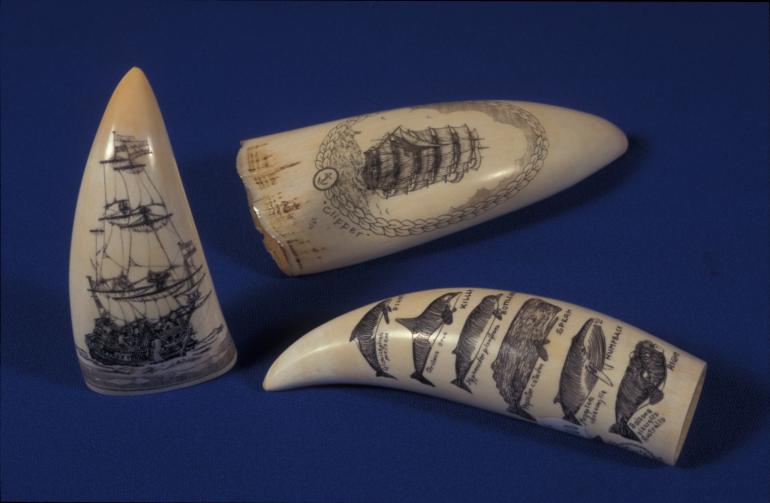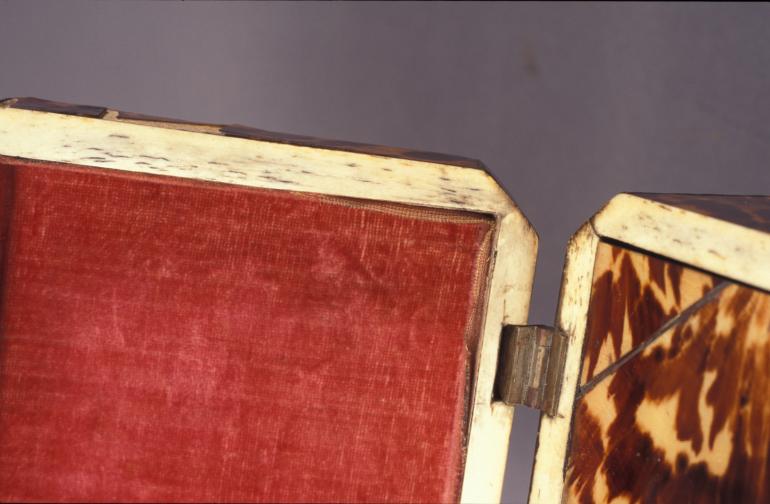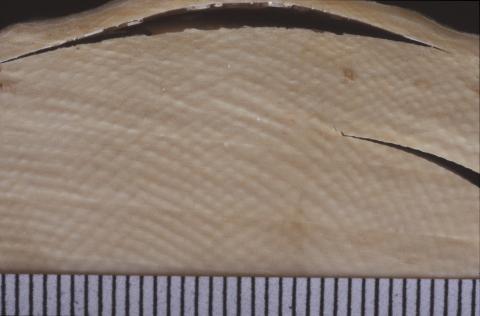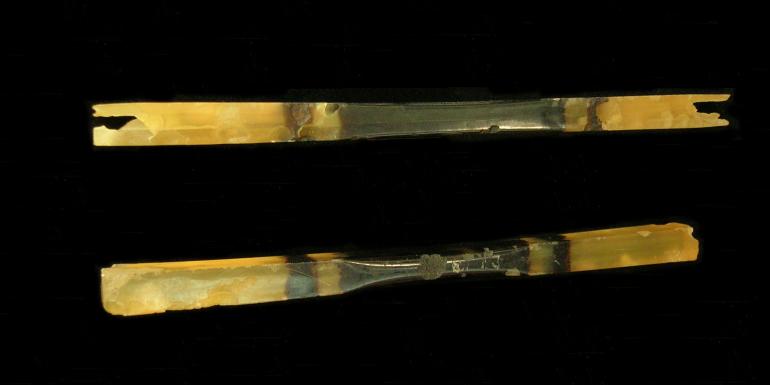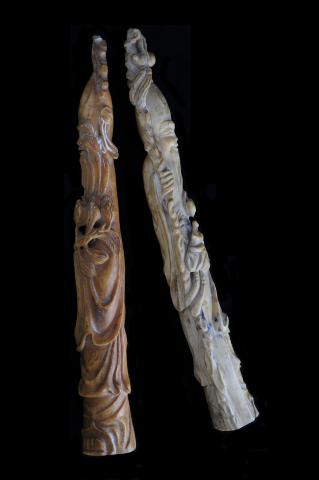Ivory, Bone and Related Materials
I. M. Godfrey
Introduction
The use of bone and ivory dates back to prehistoric times. Early people, hunting animals for food and clothing, would use as much of the beast as possible with the teeth (ivory) and bones used for arrowheads, handles and other implements. Over time this usage extended to weaponry, musical instruments, religious pieces, personal artefacts, decorative items, artistic pieces and items for games (Figure 1).
Figure 1: Examples of scrimshaw on sperm whale teeth.
When people speak of ivory, it is generally assumed that the material is from the large incisor teeth or tusks of either the African or Indian elephant. The teeth of numerous other animals including the hippopotamus, sperm whale, narwhal, walrus, wart hog and wild boar have also been used for some of the purposes mentioned above. Fossil ivories of the mastodon and the mammoth have been carved. An expert is able to distinguish between ivory types by examining differences in grain, colour, texture and hardness. Due to physical and chemical changes that occur in burial environments however, the identification of archaeological ivory can be very difficult, if not impossible, depending on the ivory type and the size and shape of the object.
As the structure of bone is more open than that of ivory, it is more easily stained and coloured. Bone can be difficult to differentiate from ivory when worked and polished with oils and waxes. Horn, baleen and tortoise shell are all skin-based materials that have been used for similar purposes to bone and ivory (Figure 2). The Tagua nut, derived from certain palm trees native to South America, Micronesia and Africa, also resembles ivory, stains easily and can be carved in the same way as authentic ivory. It is white with a marbled appearance and has been used for buttons, jewellery and artistic carvings.
Figure 2: Close-up of box made from tortoise shell overlaid onto bone.
In 1862 at the Great International Exhibitions in London, Alexander Parkes exhibited a material called ‘Parkesine’, a modified cellulose nitrate plastic. This material was substituted for ivory in billiard balls and laid the foundations for the plastics industry. Known as French ivory and, along with other materials such as mixtures of ivory and bone dust mixed with chalk, gelatin, gutta-percha and plaster of Paris, cellulose nitrate formed the basis of an extensive industry in synthetic substitutes for natural materials.
Today pigmented polyester resins are used to imitate these earlier works of art. Normally a silicone mould is made of the original and then pigmented resin is poured in. Once set, the surface can be treated with paint or dye to highlight any surface details. The opaque nature and uniform colour of these copies are usually sufficient to identify them.
Nature and Composition
Bone-like materials (ivory, bone and antler) are made up of both organic and inorganic components. The major organic component is the fibrous protein collagen. This makes up about 25 - 30 % of these natural substances with most of the balance being made up of inorganic calcium phosphate containing small amounts of magnesium and carbonate. Even when dry these mineralised tissues contain up to 10 % water. Skin derivatives such as horn, baleen and tortoise shell have the sulphur-containing protein keratin as the main constituent.
Vegetable, or palm ivory is composed of almost pure cellulose, the fundamental constituent of the cell walls of plants while synthetic ivory substitutes can be prepared from a variety of different materials (see above).
Identification
Although it is often difficult to differentiate between bone, ivory, horn and synthetic substitutes, an examination of the morphological, surface and structural features or of the chemical composition of a material usually allows a positive identification to be made. A high quality hand lens and examination of photographs or photomicrographs which highlight structural features makes it easier to identify these materials (Penniman 1952). Antler and bone, although difficult to distinguish from each other in a worked piece, can be distinguished from ivory with a hand lens. This is because the ivory contains none of the microscopic pores that, in life, contained the blood vessels that fed the growing bone or antler.
Morphological features such as the shape and size of the materials in their unworked state, together with elements such as the marrow cavity in long bones and the pulp cavity in tusks may aid the identification process.
Ivory is basically another form of bone called dentine. Despite their different structures bone and ivory have similar chemical compositions. Thus, unless some material is available for destructive analysis, chemical tests cannot usually distinguish between bone and ivory.
Features which may identify elephant ivory include:
- the pattern of intersecting arcs, usually referred to as ‘engine turning’ or Schreger lines, which are found on the cross-sectional (transverse) surface. These are quite clearly visible on African elephant ivory (Figure 3) but are slightly more difficult to observe on Indian elephant ivory;
- the presence of slightly wavy or braided continuous lines on the longitudinal surfaces;
- the presence of ‘cloudy’ areas, which are sometimes wavy, on longitudinal surfaces. These ‘clouds’ appear as areas which are whiter and more opaque than the material between them.
A further characteristic of all ivories is their fluorescence with a bluish light when irradiated with long wave ultra-violet (UV) light. Depending on the ivory type, this fluorescence varies from bluish-white to a deep violet blue (Penniman 1952). The difference in fluorescence from old ivories also may be useful in distinguishing old from new surfaces, as an aged patina fluoresces in mottled yellow tones while newer ivories and restorations usually appear deep blue-purple. Synthetic materials often exhibit a brilliant fluorescence, quite different from the natural substances.
Figure 3: Elephant ivory showing intersecting arcs (Schreger lines) which help to identify this material.
Identifying features of bone include the following:
- generally lighter in weight than a similar sized piece of ivory;
- the presence of a porous cavity often visible on the back surface of an artefact;
- the presence of small pits that held the blood vessels and short longitudinal striations. These often appear as very small dots and darkened lines on the longitudinal surfaces, features which are enhanced by dirt which collects in them.
Microscopic examination, including the use of polarised light, or an examination of materials under UV light may allow materials such as horn, baleen, tortoise shell and vegetable ivory to be identified. Vegetable ivory is characterised by the presence of very fine, slightly darker concentric lines on the transverse surface and by numerous star-shaped pits throughout the tissue.
Vegetable ivory and man-made alternatives to the natural bone-like materials can be differentiated easily by spectroscopic or chemical methods. Infra-red (IR) spectroscopy in particular, allows for rapid and usually unambiguous identification of polymeric substances (ivory copies). This type of analysis must be carried out by an expert. Although IR analyses are usually destructive, only a small amount of material (less than one milligram) is required for testing. Careful analysis of IR spectra can also provide valuable information about the degree of degradation of bone and ivory, providing valuable information about changes in the amounts and compositions of the organic and inorganic components (Godfrey et al 2002).
A very simple, though destructive, method of determining whether a material is composed of a synthetic substance is the ‘hot needle’ test. Many of the polymeric materials used as substitutes for bone and ivory will melt when heated. A hot needle applied to an inconspicuous part of an object should give a quick, though not reliable estimate, of the composition of the object in question. Because of the destructive nature of this test, however, it is not recommended.
For full descriptions of the methods available to differentiate ivory, bone and related materials refer to Penniman (1952), Thornton (1981), Krzyszkowska (1990), Locke (2013) and Mann (2013).
Deterioration
Bone and ivory have directional properties (are anisotropic) and are therefore susceptible to warping and cracking on exposure to moisture and heat (Figure 4). This is especially so for thin artefacts where even moisture from the hands may be damaging. Warping and cracking are essentially irreversible. Bone and ivory are also prone to chemical attack and staining.
Deterioration processes which affect bone and ivory include:
- warping and cracking due to changes in relative humidity and temperature. Ivory is particularly sensitive to changes in relative humidity;
- chemical and bacterial degradation of the protein component of bone and ivory. This is enhanced by prolonged exposure to water and/or burial in aerobic sediments;
- attack on the inorganic components of these materials by acids. Artefacts that were previously buried in an acidic soil will usually be degraded and fragile;
- attack on the organic components by alkaline reagents. A soft and crumbly matrix is the result of substantial collagen loss;
- bleaching by direct sunlight and UV radiation. UV exposure will also cause weakening of the collagen matrix and yellowing of the natural oils found in ivory;
- damage by heat. When burnt these materials become grey or blue-black in colour;
- contact with sulphur-containing compounds (for example, some rubbers and certain paints), which will turn ivory an unnatural yellow-orange colour;
- staining due to contact with corroding metals such as copper and iron. The porous nature of these materials makes them very susceptible to staining.
Figure 4: 19th century Chinese ivory screen and stand showing cracking.
Ivory tends to develop an attractive yellow-brown patina as it ages. Do not attempt to remove this patina as it is part of its history, similar to the patina developed on a pewter tankard.
Horn, baleen and tortoise shell react in similar ways to those outlined above for bone and ivory. In addition, insect pests such as dermestids have a healthy appetite for keratin and can cause considerable damage to these materials (Figure 5). Avoid contact between water and thin films or delaminating surfaces of these materials as softening and deformation are likely to occur. As many tortoise shell objects are composites of smaller pieces ‘welded’ together with heat, moisture and pressure, they are particularly susceptible to damage in a fluctuating relative humidity environment.
Figure 5: A pair of Japanese hairpins (1900 – 1930s) in cow and buffalo horn (yellow and black respectively) showing several points of attack by dermestid beetles (copyright: Gordon Turner-Walker).
Cellulose nitrate, of which French ivory is composed, is an unstable chemical compound. As French ivory ages it develops a patina that is similar to that of ivory. Rather than being desirable, however, the development of this patina is an indication of the first stage of the potentially hazardous degradation of this material (see the chapter Modern Organic Materials). Loss of plasticizers from the cellulose nitrate (identifiable as weeping from the surface) may cause cracking and crazing of the object. As thin films of cellulose nitrate have been known to combust spontaneously, isolate deteriorating artefacts from other materials.
Preventive Conservation
For conservation purposes ivory, bone, antler, horn, baleen and tortoise shell may be treated in the same manner, as they react in similar ways to given environments and treatments. For convenience, from this point all these materials will be referred to as ‘ivory’.
Although ivory artefacts are reasonably durable, as is evident from the age and condition of many prehistoric materials, they can be damaged readily if improperly cleaned, handled, stored or exhibited.
Environment
Because of the sensitivity of these materials to changes in relative humidity, keep them within a temperature range of 15 – 25 °C and a relative humidity range of 45 – 55 %, with no more than a 4 °C and/or a 5 % swing respectively within a 24-hour period. It is desirable to maintain an environment with a steady relative humidity and temperature and, most importantly, to prevent exposure to extreme conditions or rapid fluctuations.
Volumetric changes for ivory are at a minimum between 30 - 40 % but this is a risky low relative humidity for many objects. For example, a change in relative humidity from 40 % to 45 % causes a volumetric change of only about 0.35 % while a change from 60 % to 65 % causes a 1 % volume change. The effect of relative humidity changes on an object depends upon how it was cut from the tusk. Dimensional changes in the longitudinal direction are minimal and radial changes do not become apparent until above 50 %. Changes in the tangential changes are almost linear between 30 % and 100 % relative humidity, with an average increase of approximately 6 % (Turner-Walker, 2017).
As ivory materials are affected by moisture, avoid dramatic changes in relative humidity. Usually, materials from tropical regions will have a higher moisture content than similar materials from drier areas. For this reason, slow acclimatisation to a new environment is essential in order to reduce the possibility of cracking or splitting (see the chapter Preventive Conservation: Agents of Decay).
If stored in the dark, ivory appears to darken in colour. This is due to a natural and slow ageing process that leads to the development of a pale yellowish-brown patina. In the presence of light this ageing is counteracted by bleaching of the ivory surface. Ivory materials should never be placed in direct sunlight or bright artificial light however as fading of colourings and dyes or an overall bleaching of the surface will occur.
If ivory is dyed, do not allow light levels to exceed 50 lux with the UV component restricted to 30 µwatts/lumen (1500 µwatts/m2). For undyed material illumination levels should not exceed 200 lux with the UV component restricted to 75 µwatts/lumen (15000 µwatts/m2).
Handling
To prevent staining of the surface, wear cotton gloves when handling ivory materials, except for some archaeological ivories where raised splinters and cracks can catch on the knit of the cotton gloves.
When packing ivory for transportation ensure there is an adequate buffer against both physical damage and changes in temperature and relative humidity. Wrap artefacts in acid-free tissue, place in a sealed polyethylene bag, wrap with bubble wrap and then pack in an insulated box. The aim is to control the temperature and therefore the relative humidity within the sealed bag.
Storage and Display
Place ivory within a display case or cabinet as these provide protection from dust and dirt and also buffer changes in temperature and relative humidity. Due to the emission of acidic vapours from some timbers, metal cabinets are preferred to wooden ones.
Store ivory under low light and low UV levels (see Environment above). As light bleaches the surface of ivory considerable variation in colour may occur unless objects are moved in relation to the predominant light source (Figure 6). The effect of different exposures to light is usually evident in the differing colours produced on the front and back, or upper and lower, surfaces of objects. Ensure lighting has no effect on the internal temperature and hence the relative humidity of display cases used to house ivory artefacts (see the chapter Preventive Conservation: Agents of Decay).
Figure 6: Chinese sage carved from a juvenile elephant's tusk showing the effects of light causing differential colouration. One side was continually exposed to the sun over a 10 year period, leading to yellowing, drying and eventual irreversible splitting (copyright: Gordon Turner-Walker).
Additional storage and display considerations include the following:
- use inert materials, such as spun polyethylene or polypropylene to line storage shelves to provide cushioning;
- do not use rubber pads or adhesives near ivory as the sulphur in these materials will discolour ivory;
- avoid contact with iron, copper alloys and coloured materials as staining may result; and
- inspect horn regularly as it is the material most likely to suffer from insect attack.
Treatments
Very fragile ivory artefacts should only be treated by conservators. Artefacts in reasonably good condition may be cleaned of surface dirt and grime if proper precautions are observed. Refer to a conservator for the treatment of stains caused by contact with corroded metals or coloured materials.
Before cleaning or any other treatment, examine the object carefully to identify the nature of the material, to determine the strength of the object and to note whether it has been patinated or decorated. If the material is fragile, support it on a padded block which can be moved without direct handling of the object itself.
Examination
Guidelines for examination include:
- using a binocular microscope if possible. This will help estimate the depth and extent of cracks and the amount of deterioration;
- using micro-tests to determine the material of any decoration and how it is applied, as well as to determine its condition and ability to undergo any proposed treatment;
- noting and recording the presence of cracks (extent and depth), accretions, stains, old repairs, and new or recent damage; and
- observing objects under a long wave UV light (320 – 400 nm). This is usually helpful in locating old repairs and some accretions.
Cleaning
Objects in good physical condition may need only gentle dusting with a soft brush.
If brushing is not sufficient to remove the dirt and grime then careful wet cleaning may be attempted. Great care is needed if wet cleaning techniques are used. Water is potentially very damaging to these materials and non-polar organic solvents, such as toluene, have been shown to affect the organic components of ivory (Matienzo and Snow 1986). Ivory, for instance, has even been damaged by the application of damp swabs. Consultation with a conservator is highly recommended.
Follow the guidelines below if wet cleaning is necessary:
- never immerse an ivory object in water and do not apply water to cracked or porous surfaces;
- test any solvents on an inconspicuous part of any painted or decorated surface before any cleaning is attempted;
- roll a cotton bud, moistened with solvent (see below) over the surface to remove dirt. Clean only a small area at a time;
- immediately dry the surface with another cotton bud or soft tissue; and
- if necessary, remove residual soap with a cotton bud moistened in distilled water. Dry the surface immediately.
Solvents which have been used to clean ivory include:
- water;
- a solution of water and alcohol or methylated spirits (50:50);
- water containing a non-ionic detergent (see the chapter Ceramics);
- white spirit;
- white spirit containing a soluble detergent (such as Vulpex B-30); and
- leather cleaner (see the chapter Leather).
Leather cleaner has been found to be very effective. This cleaner has appeal as it has a low water content and its combination of a non-polar solvent and a non-ionic detergent, allows a range of surface contaminants to be removed. Care must be taken when cleaning ivory materials which have been deliberately painted as these attempts at cleaning may damage the original work. Even more care is needed when dealing with thin films of ivory as these are particularly susceptible to water damage.
Repair and Consolidation
Although it is strongly recommended that repairs and consolidation are left in the hands of experienced conservators, those with good hand and practical skills may feel confident enough to attempt simple repairs. Consult a conservator before taking this step however.
Objects that are broken or cracked can be repaired using pigmented resins. Do not use epoxy-based resins however as they yellow with age and cannot be removed by dissolution. This latter property makes future removal and re-treatment difficult. A further disadvantage of epoxy-based adhesives is that the adhesive is stronger than bone and ivory. Should further breakage occur it is best that the repair fail rather than cause a new break adjacent to the previous repair. Never using cyanoacrylate superglues for repairs. These have very low viscosities and run everywhere. The go deep inside the structure, closing off pores and are impossible to remove. They will cause differential responses to relative humidity changes and are capable of carrying dirt deeper inside the object.
If the ivory is flaky, powdery or delaminating, it may require consolidation using a resin and solvent combination such as Paraloid B-72 in acetone. For better penetration, work of this type should be carried out by immersion in a vacuum chamber. Colloidal dispersions such as Primal WS 12, WS 24 and WS 50 also can be used. These have better ageing properties than emulsions and due to their smaller particle size and viscosity, are better able to penetrate the ivory matrix.
Summary
- Ivory is extremely sensitive to changes in temperature and relative humidity. Maintain environmental conditions in the ranges 15 – 25°C and 45 – 55 % with no more than a 4 °C and/or a 5 % swing in temperature and relative humidity within a 24-hour period.
- Never immerse ivory in water or wet the surface.
- Always wear cotton gloves when handling ivory.
- Keep light levels low and even. Recommended light and UV levels are 50 lux and 1500 µwatts/m2 respectively for dyed ivory and 200 lux and 15,000 µwatts/m2 for undyed ivory.
- Acclimatise ivory slowly whenever it is moved from one climatic zone to another (tropical to temperate and vice versa). This is essential to minimise cracking and warping.
- Display ivory objects in a case to help buffer against rapid changes in relative humidity or store wrapped in acid-free tissue in an acid-free box.
- Obtain advice from a conservator before attempting cleaning or other treatments.
Bibliography
Godfrey, I.M., Ghisalberti, E.L., Beng, E.W., Byrne, L.T. and Richardson, G.W., (2002), The analysis of ivory from a marine environment, Studies in Conservation, 47:29 45
Krzyszkowska, O., 1990, Ivory and Related Materials: An Illustrated Guide, Bulletin Supplement 59, Institute of Classical Studies, London.
Locke, M., 2013, Bone, Ivory, and Horn: Identifying Natural Materials, PA Schiffer Publishing Ltd, Pennsylvania.
Mann, W.R., 2013, Ivory Identification: A Photographic Companion, CreateSpace Independent Publishing Platform.
Matienzo, L.J. and Snow, C.E., 1986, The chemical effects of hydrochloric acid and organic solvents on the surface of ivory, Studies in Conservation, vol. 31, pp. 133-139.
Penniman, T.K., 1952, Pictures of Ivory and Other Animal Teeth, Bone and Antler, Occasional Paper on Technology, 5, Pitt Rivers Museum, University of Oxford.
Thornton, J., 1981, The structure of ivory and ivory substitutes, in Preprints, 9th Annual Meeting of the American Institute for Conservation of Historic and Artistic Works, May 27-31, 1981, American Institute for Conservation of Historic and Artistic Works, Washington D.C., pp. 173-181.
Turner-Walker, G., 2017, personal communication.

